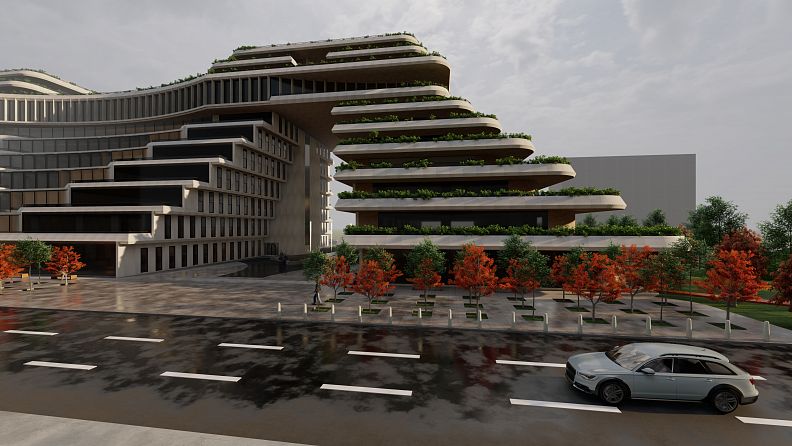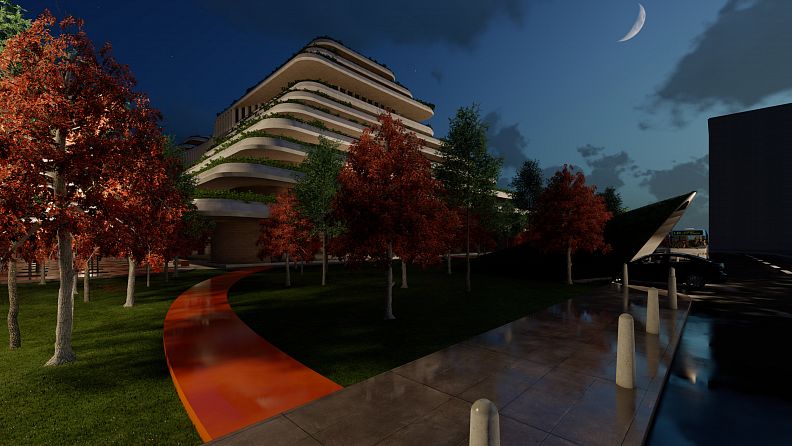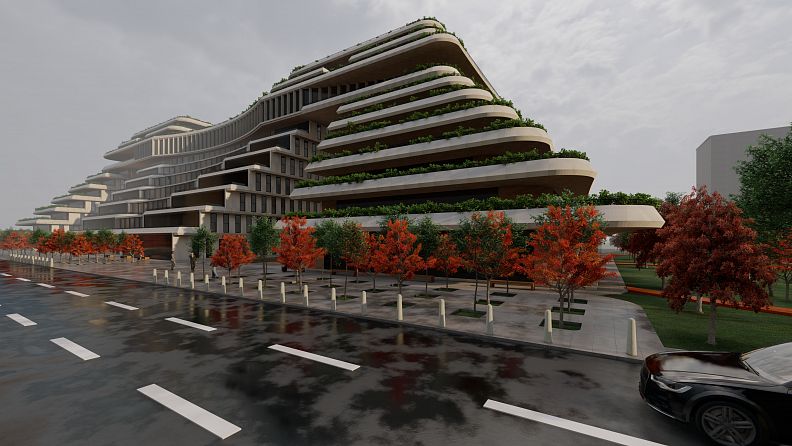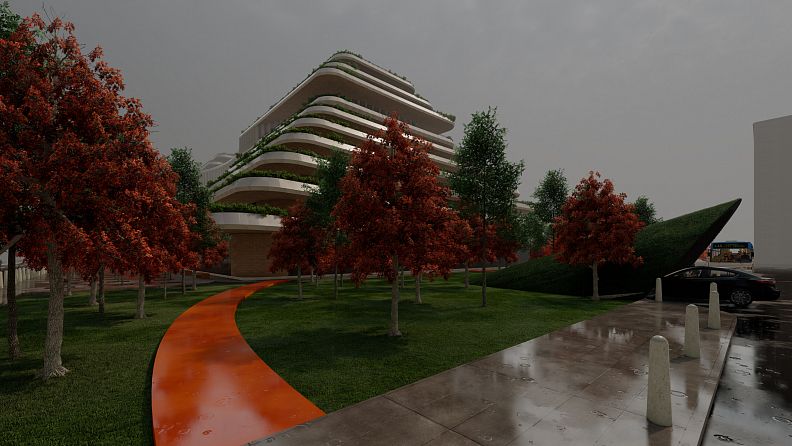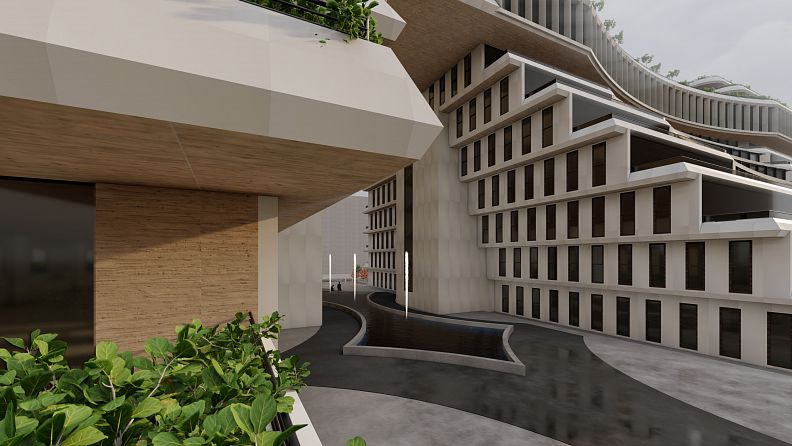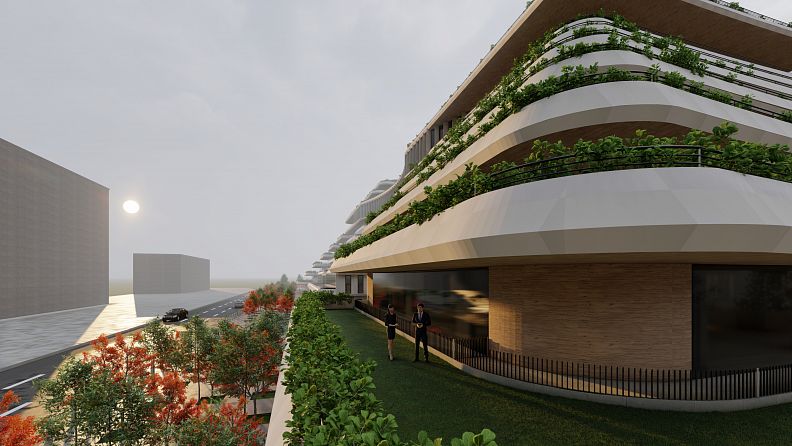Design of mixed-use building

Project idea
The developed project aims to provide solutions to the key problems that the capital of Prishtina has. After reviewing the case studies, the review of this typology in developed countries, as well as in developing countries, local urban rules, and the economic-social-cultural situation of the population, as well as the development period of Prishtina, has reached the result presented in the following sheets, the design of a building with different functions with hybrid interconnection, where great importance is given to new concepts of design of biophilic and bioclimatic buildings.
Prishtina's urban problem of human overcrowding and vehicles, pollution, environmental degradation and insufficient infrastructure is not only due to overcrowding, but also improper planning has a major role in this degradation. There can be two approaches to fixing this problem. One is to expand the city and create auxiliary suburban cities with proper planning or densification of Pristina. In the first solution, the direction of traffic (human and vehicle) outside Prishtina can be considered, through the creation of sustainable suburban cities. While in the other case the densification of Prishtina can be done through, re-planning and urban structuring, multi-storey structures to increase the density, and design of buildings with mixed use. Prishtina, like most cities in developing countries, is not crowded. Therefore, most of the urban problems faced by these cities can be solved gradually with structured densification through a systematic urban structural planning and regulation. This may mean that some unused properties (buildings, land, etc.) will have to be erected gradually or developed into single-density single-use or mixed-use structures. (Preferably with mixed-use building design). Although not all residents can live and work in the building with mixed functions, an excellent balance can be achieved through careful research in the target population of a particular development. The objectives are to identify some of the principles of urban design used in solving the urban model of congestion problems (vehicle and human), urban sprawl, etc. Conduct research on the concept of mixed-use building developments as an urban approach model. Identify different types and functions of mixed use building developments. Demonstrate how the concept of mixed-use building development can be used to solve some of Prishtina's urban problems.
The main purpose of this study is to create indicators of mixed-use buildings that are essential for a sustainable development of mixed-use buildings. Also, this study used more unified criteria for assessing sustainability which include the socio-cultural, economic and environmental dimension versus the mono-dimension with its shortcomings that were reported in the literature as inadequate. It is also clear that mixed-use construction reduces crime, provides security, and improves social welfare. After all, indicators are guidelines and parameters that are indicative of sustainable development in general and a critical determinant of the sustainability of mixed-use buildings. The configuration and subsequent operation of the mixed-use building allows for some functions which prompted separation from this study towards the realization of appropriate parameters, which do not allow the design and evaluation of mixed-use buildings. Critical indicators will eventually assist decision makers and professionals in the construction industry in assessing the sustainable performance of mixed-use buildings and making informed informed decisions. The study also contributes that the existing body of knowledge is one of the main efforts, aimed at developing mixed-use building projects to improve the practice of sustainability within the construction environment. The messages after this work are for the construction to be oriented by buildings with mixed functions, with green terraces, with new biophilic and bioclimatic trends, as a solution to the many problems in Prishtina which were mentioned earlier. With these construction principles it is possible to improve the quality of life and the living of the inhabitants to be healthier, with easier access to services, and less stress. Considering also Vitruvian orders (firmitas, utilitas, venustas), (durability, function, beauty). My scheme must provide economic opportunities, welfare, social equality, environmental sustainability of our limited natural and environmental resources, must include pleasure, merchandise and culture, and be acceptable to the human eye. An example of a life in this typology is that I am writing it from my office upstairs, near the corner from my favorite restaurant and down the street from a wonderful oasis walking with my kids. This generates a catalyst for building compact, complex and social neighborhoods, competitive trade because it facilitates efficient entry into places where people work, live, play, walk, ride a bike, and shop. Why live a more complex life where we have to work in one place, live in another, go shopping elsewhere and all this must be achieved by describing long distances in most cases even by car, when adequate solutions for a simple and healthy life is the building with mixed functions.
In the city as in the countryside, in the apartment as at home. After reviewing the key problems of Prishtina and after reviewing the literature to find the ideal solution for developing cities such as Prishtina in this case, with a very high pollution index, traffic congestion and lack of numerous green spaces, I have It was concluded that the best solution is to expand the Prishtina model to the west in the new Prishtina, to develop the model of the building with mixed functions. The first case study was not taken as a proper solution as it is not suitable for the economic level, urban growth, psycho-social development and our urban silhouette. As the best solution for us as a developing city is the building with medium floors and density and with hybrid interconnection in equivalent vertical and horizontal extension in several lamellae. This development enables many facilities for residents and affects the improvement of their health. In a building with many functions such as housing, medicine, business, shops, market, office and administration, etc., the road is shortened for the residents to reach the necessary service and it is almost unnecessary to use fuel cars, which is one of the main generators of environmental pollution. To choose the appropriate location I have based on the urban regulatory plan of Prishtina in the area expanding to the west. To reach the adequate form, where all the functions are interconnected with each other without circulation problems, I achieved through the process of creating the architecture of the building through the architectural design from the idea to the architectural object. The concept is based on the relationship of 2d shapes as well as the cyclical relationships of influential factors in the process of architectural design. To give another dimension to the appearance of the building is used the principle (Think out of the box), using traditional schemes, but also thinking beyond them (figure). Macro and micro urban analyzes (figure). The project also adhered to the urban regulatory plan in the western part of the new Prishtina development (figure). To stay with the cultural connection of Prishtina, part of the concept of the shape of the building has been added the entrance to the throne, its elegant forms are used to achieve a perfect shape (figure). The figure in question represents a female deity, reflecting the cult of the great idol of the mother and preserved in the Museum of Prishtina. The Museum of Kosovo has adapted the image of the "Goddess on the Throne" as the logo of the special institution. Moreover, as it is one of the most precious archaeological artifacts of Kosovo, it has been adopted as a symbol of Pristina.
Project description
Mixed-use architecture is the practice of allowing more than one type of use in a building or group of buildings. In other words, it could mean a combination of residential, commercial, industrial, office, institutional or other uses. This tends to create shorter distances between work, residence and recreation and goes a long way in increasing the livelihood of residents. It is also very effective in preserving the environment, as almost all the necessary services are in the building or around it, which allows a short way to get a service and the use of fuel cars is almost unnecessary and more in this direction we go towards architecture that enables 0 carbon imitation. A mixed-use building aims to combine three or more uses into one structure. Whatever the combination, it combines several uses within a building or in a small area.
Mixed-use buildings are objects with more than one use. The structure of a typical mixed-use building allows the entry of at least two groups of users, where both groups benefit from the presence of the other. Proponents of compact city policy argue that mixed-use buildings are necessary to achieve compactness. Demand for density in developing cities is growing as land prices are rising and there are almost no vacant plots in the centers. Although there are no universal measures for low, medium and high storeys, I believe it can be related to the location and characteristics of the city. In some countries ultra-high densities are generated by different conditions and local origins and can not be compared with European examples, or with our urban development, also, terms based on low-density, medium and high-density buildings, different meanings and values in small, medium and large cities, especially for developing cities like Prishtina.
Some benefits include: greater variety and density of housing, better energy efficiency and sustainability, stronger neighborhood character, better integration with city services such as public transport, more flexibility to adapt to changing needs, thus increasing the long-term life cycle of the building. This type of planning can transform a business circle that closes at night into an area that is lively all the time. It can bring together people you would not normally meet, pick up cars off the road and even provide much-needed oases of nature. Mixed-use buildings always need some sort of entrance control system to ensure that residents, shoppers, and business people only have access to common areas and their private locations. Transportation solutions play a big role in keeping these areas segregated as they get people to their destinations as quickly as possible. Benefits of nearby services, economic and environmental.
Technical information
The floor plans considered in the topic are only those of residential housing, without including duplex dwellings and other functions. There are several different typologies examined (figures). It is important that all typologies of dwellings continue in verticality, but each floor as seen in the figure is reducing the dimensions and attraction. Dwelling life is a uniform organization of living in the community / collectivity, through common interests and things in common but often with inconsistent tastes and needs of people of different age groups, professions and generations (parents, children and grandparents). The purpose of housing typologies is to provide sufficient flexibility for families of different compositions to create a healthy environment that promotes the proper physical and mental development of residents in a family and in the community that embodies this housing - collective housing. The solution of the organization and extension of the apartment is made taking into account all the vital processes that take place in it - the attitude, commitment / profession of family members, management, food preparation, communication of family members among themselves and with other persons, as well as personal maintenance and hygiene. Zoning is done in each apartment by dividing the areas, service area with private and social. Where the noisy and quiet area of the building is treated. Aspects of economy and efficiency of operation of multi-apartment buildings have been incorporated since the first stages of design. To define the economic efficiency of the planimetric composition of a dwelling / apartment, the main factors are the habitable and usable area in m2.
The main materials used in the exterior facade are different, mainly from the laminate manufacturer. Some of them are expressed below. Environmentally selected materials that guarantee the highest performance. Among these, Laminam tile is used both internally and externally due to its natural composition and environmental compatibility, as well as for its resistance to external stress and its aesthetic qualities. Particular use has been made of the Focus Piombo finish, both inside and out, by the band that characterizes the exterior architecture and serves as an innovative elevator to the terraces, to the interior floor in the fitness room. The collection, whose origin lies in the initial force of nature expressed through pure and essential elements such as Rock, Lead, Earth, Salt, is combined with Laminam tiles with wooden appearance, respectively Legno Venezia, with the completion of Sabbia, installed in exterior terrace ceilings. Minimum thicknesses of 3 and 5 mm, reinforced at the back with fiberglass, facilitate installation even at high heights and ensure high technical performance in terms of resistance to marks, scratches, impact and wear, sudden changes of temperature and UV rays. Environmental sustainability, style integrity, research and design, innovation, has led to the ideal choice for the exterior facade. This is because architecture can respect humanity, nature and society and ensure that they coexist in total harmony. It uses a completely natural material, but at the same time technologically innovative: Large size Laminam tiles, with minimal thickness, from the Filo series in Brina color. Filo is known for its stunning structure, inspired by the image of an infinitely repeated iridescent thread, intertwined so that it blends seamlessly into a metallic fabric. The Brino and Rame color used to cover the airy façade is a clear reference to the golden color, a precious metal. Filo series tiles with a metal thread can not be cleaned with acid-based products. If the adhesive residue or dried filler (cement or epoxy) is not removed immediately, it may become impossible to remove. We recommend cleaning the surface quickly at the end of the installation and storage operations with water and gently, cleaning the sponge to ensure the removal of all debris. If acid / alkaline detergents are used, they should be tested in a concealed area and rinsed immediately. While in the office and administration spaces are used moving profiles for light control and ventilation. The cover of the green terraces and vegetation is from a new layer. Urbanscape® - Izolim Knauf. Urbanscape® Green Roof is a lightweight and easy-to-install system with a high water-holding capacity, created specifically for green roofs on all types of flat roofs. Urbanscape is a complete system consisting of a root membrane, drainage system, Substrate Green Roll and a sedum-mix vegetation layer. The substrate is the wise part, made of a mineral wool without bonding chalk. With a saturated weight around. 1/3 of land-based systems, Urbanscape has great logistical benefits (a 20 mm roll pallet is equivalent to 14 tonnes of land per 100 mm). It is therefore very suitable for both reconstruction and new construction.
